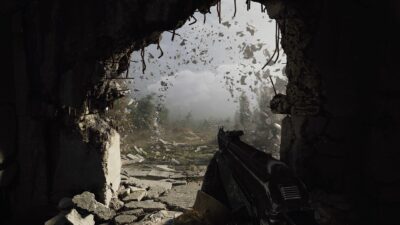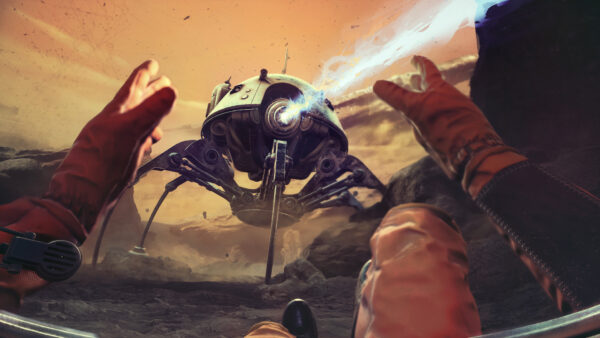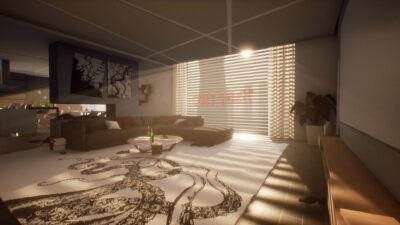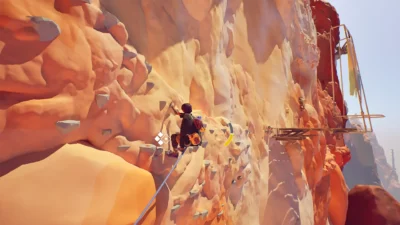
NB: A condensed version of this article appeared in Wireframe #3.
British game designer Julian Gollop has created some of the best strategy games ever made, from Chaos and Rebelstar in the 1980s to X-COM in the 1990s to the sorely under-played Ghost Recon: Shadow Wars in 2011.
Now, Gollop’s back with Phoenix Point, developer Snapshot Games’ new turn-based tactics game in the sci-fi tradition of the classic X-COM. Like that 1994 hit, it sees Earth under threat from invaders – this time, an alien virus capable of twisting human and animal DNA into horrific new forms. Fans of X-COM (not to mention Firaxis’ reboot, XCOM) will recognise the turn-based skirmishes and global-level strategising, though the use of procedural generation to create a changing, unpredictable enemy promises to give players an evolving challenge.
To find about more about Phoenix Point, we caught up with Gollop on Skype, where we also talked about the making of its forebears, Rebelstar and X-COM, and his thoughts on what makes a believable (and entertaining) computer-controlled opponent.
The procedurally generated aliens: could you talk about how that concept came about?
The idea was to find something that was alien but not quite so alien, so we generated the idea of a mutation virus. The idea was that we can combine elements of humans, creatures, and then something very alien. The mutation system is designed to give the aliens a sense of progression and change over the course of the game, and also give the player some interesting and fresh challenges. The basic idea behind it is that we’ll have one archetype creature, which is the Crabman, and he has various types of body parts. He doesn’t have very many at the moment, but he’ll have a lot more when the game’s released.
The most complex creatures are these giant monsters, which are almost like battleships in the sense that they have multiple armaments and defence mechanisms. We have a variety of combinations that number in the hundreds – body parts, abilities. It’s not easy to implement, because it’s tough on programming – everything’s built from components and they all have to work with each other. It’s quite an ambitious thing.
A tactical game is all about balance, and it must be difficult to maintain that if you have all these combinations to account for.
Sure. But for the player, there’s always something you can counter the aliens with. And usually, when you capture an alien, you can study the mutation, and it’ll give you some hints as to what you can do to counter it, or it’ll give you a new piece of equipment that you can manufacture to help you.
Even as games evolve, it seems to me that the core principles of strategy games have to stay the same.
I would say so, yes. What I appreciate about strategy games is having some really unusual situations that are generated systemically in the game that maybe no other player’s encountered before. They give you something unique to defeat or overcome in some way. I do like to build a lot of randomness in my game – though of course it’s not pure randomness, it’s sort of contained within these rational heuristics – but pretty much, I guess a lot of 4X games do this, they have random rule set-ups and lots of customisation and so on.
I guess, to some extent, Phoenix Point also has some influence and borrowing from that in a way. It’s not a 4X game in the classic sense; the initial set-up of the game has some quite random features to it, so it’s not going to be completely the same each time you play it. Which faction you encounter first, what difficulties you have with certain resources may be different, and so on.

The ability to go into an over-the-shoulder view and pick vulnerable spots on your target gives Phoenix Point’s tactics feels close to the Fallout playbook.
That randomness goes right back to Chaos, in a way. It was a single-screen strategy game, but you had a spell like Disbelieve that could completely throw someone’s strategy out of the window in one move.
Yeah, and if you’re playing with human players, it brings that whole psychological element to it.
I never played the boardgame that inspired it, Warlock.
The Games Workshop game, yeah, that was Warlock. I never actually played it either. I watched kids play it at school, because this was going back to 1980, I think. It was the early days of Games Workshop – when it was set up, they were originally producing board games. They had an initial release of four board games, and I think Warlock was one of them, or at least it was a very early one. They had a game called Apocalypse, a Doctor Who game was another one, actually.
Warlock was a very early one they did. It was played with cards, and it had a very abstract board, but the main thing I didn’t like it when I was watching people play it is that it seemed too abstract – there wasn’t a sense that you were really summoning these creatures and battling with them. It was much more of a numbers and cards-type game. I liked the idea of using cards for spells, but I had a secret hand of spells – you can’t see the other player’s spells – and it’s going to be random every time. The whole random deck construction was what made the board game really quite interesting you played it each time.

Although evidently a spiritual successor to X-COM, Phoenix Point’s mutating alien threat gives the game a ghoulish atmosphere of its own.
Looking back through your games, there’s a clear throughline from Rebelstar Raiders to Phoenix Point. What’s interesting is that you’re constantly refining and finding new ways of improving what you’ve done. So is that like a game in itself, for you, to improve on those ideas?
Yeah, even going back to the original Rebelstar, I had the idea that you had these characters – even though it’s a squad-based tactical game – these were characters in a universe and they had a story. There was something bigger and wider and more meaningful going on. Obviously, that was developed quite substantially with the first X-COM game, though with Phoenix Point it’s definitely developing it even further, of course. You have soldiers who can develop uniquely in different ways, and as with X-COM, your more powerful soldiers are the ones that you really try to protect and make sure they don’t die.
On the other hand, they’re really powerful, so you need to use them. But also, on the wider, strategic level, I’m quite obsessed with the idea of linking things at multiple levels in the game, so Phoenix Point has a strategic level which has different factions with their own leaders. Those leaders can have personalities, objectives and agendas which direct their strategic level. You as a player are intervening in this world in ways you can choose, but nonetheless will continue without your intervention.
You touched on this in X-COM Apocalypse, which had multiple factions and alliances and hostilities between them, but it’s much more fleshed out in Phoenix Point.
So at the story level, were the factions created to fit the story, or did you write the story to accommodate them?
Yeah, so the original story of the world was created early on. Then we brought in our writing team, which fleshed it out considerably – the world fiction, the backstory of the game – that became quite detailed and interesting. Phoenix Point is a near-future science fiction-style game, and it has certain horror elements in it, I guess, also – certain Lovecraftian horrors in some respects.
Going back to Rebelstar, what was it like to write the AI for that, because it must be difficult to create an AI that’s convincing, but also fun to interact with.
It was a real challenge. The first game in the series was Rebelstar Raiders, and that was a two-player game, single-screen. The sequel was just called Rebelstar, and that was originally also a two-player game. When I took it to show TelecomSoft, who were publishing the Firebird and Rainbird games, they said they needed a single-player version of the game. I thought, “Oh shit, how am I going to do this?” I actually holed myself up in my room, because I was at college at the time, and I spent two weeks implementing the AI. I managed to do it in that timeframe, and I think all the data and code for the AI was contained in something like three-and-a-half K of memory. It was relatively simple, but that was how it came about. It worked – but only just!

The forebears of X-COM and Phoenix Point, the Rebelstar games packed some engrossing turn-based action into just a few KB.
In that and the sequel, the AI made you feel like you were playing against a proper opponent – one that actually had weaknesses you could exploit. So as a designer, what is the approach to making AI fun to interact with?
The trick is that you want the player to be able to recognise patterns and behaviours. And once you’ve understood how the enemy’s working, you can devise a counter-strategy that works. Then the player feels like they’ve achieved something – they’ve outwitted the aliens that are more powerful. The other trick is, with AI, is that it needs to respond in some way. It needs to throw up a new situation for the player – it’s usually done in many games either by throwing in new types of units, or in some way changing the behaviours of the aliens themselves. You want to give a sense to the player that the AI is also thinking on a longer-term strategic level.
You can put random aspects into that, and it kind of makes the AI seem more intelligent because it’s doing something different, even though it may have just randomly picked it. In terms of the player’s internal narrative, the AI’s responding. In fact, in games that involve prediction and bluff, some kind of element of randomness used in the right way is in fact often the most intelligent thing to do, because you don’t want to be totally predictable to the player. You need to keep players on their toes somehow.
That randomness, as you say, is how flawed, sometimes irrational human beings behave – when their backs are against the wall they make odd decisions.
Yeah, they make odd decisions. In Phoenix Point, the aliens have a strategic level of AI. They will abandon mutations that no longer work very well against the player. The mutation system itself is quite random, so it will throw up some combinations to the player that aren’t very strong, but it will also throw up some that are challenging. The idea is to give the player an occasional surprise, so they have to adjust their strategy and figure out what to do.
I saw in a recent interview, you said something like, “The original X-COM succeeded in spite of itself.” I believe it was a difficult game to develop, X-COM?
It was. Part of the problem was that bits of the game were only joined up together near the end of development. The problem was, how can I test it from start to finish? If I do test it from start to finish, and make various adjustments, how do I then test it again? I could be here for years. This is the conundrum that we had. Even though we had a dedicated team of QA testers on the game for the last three months or so of production, the testing I was doing for the game balancing was kind of split. I would say, “I’ll try and test the early game. I’ll try and test the mid-game.”
Testing the late game proved more difficult – that’s where the game falls apart a little bit, actually. It was very difficult to do, because it was so systemic – something that happens early in the game can have a knock-on effect later on, which can either make the game too easy or too difficult, or even impossible to finish. It’s the risk you have with these long, complex strategy games.

Regarded as one of the finest PC games ever made, X-COM spawned a franchise that’s still going today.
With your recent games, like Chaos Reborn and now Phoenix Point, you’re creating games in an online environment where you can get feedback from players pretty much instantly. So how has that change been, given that in the 80s you had no feedback until release?
Yeah, in the eighties I was the main audience for my games when I started out. If it didn’t work for me, then I thought, well, that’s enough. These days, that has got tremendously complicated. In the case of the Phoenix Point audience, a substantial number of them are players of the original X-COM games, for example. They really do want something very similar to that experience, right down to the mechanics.
Then there’s the audience who’ve only played the new XCOM games – they want something a bit more visceral, a bit more streamlined and easier to play from an interface point of view. Then there are people who’ve played neither – they might be into these tactical RPG-style games, whether it’s Wasteland or Fallout or whatever.
Managing audience expectations there is quite difficult. You have to be careful – you may get feedback when people are complaining about something, but it’s only a very tiny number of people, and they’re only complaining because it’s not the way it was done 20 years ago, kind of thing. So it’s easy to collate the feedback, but how to respond to it is actually much more difficult, because you can’t just listen to every person that makes a comment. There are raging debates on the forums about all kinds of stuff. When it comes to something like character progressions – do we want a class-based system or do we want something more open-ended like the original X-COM, where everyone accrues stats and become super-soldiers?
Somebody did a poll: “Which do you prefer”. Most of the vocal people were saying, well, we don’t really like class-based system, but then we get the poll results, and 70 percent of people say we do want it. You can’t please everybody. You have to say, “Well, what’s working best in the context of the game, and how do you justify these decisions in the overall gameplay?” In Phoenix Point, we tried to do something interesting: you have a class-based system, but you’re allowed to take one soldier and give him a secondary task or a tertiary class if you want, and each class represents a set of abilities that are derived from training in that particular specialisation. So in Phoenix Point, you can have characters which draw on abilities from different classes, or you can have one that’s really specialised in one area. I quite like that flexibility, and I think it’s going to work out well.
You worked with Ubisoft for a while, and I thought Shadow Wars was an amazing early game for the 3DS. What was your experience of working with them like?
That was actually a launch title. There were only about 17 or 18 launch titles. You could say the 3DS had a really bad launch all round, actually – the machine wasn’t actually finished. We had features on the dev kit which were not working at the time of launch.
I made Chessmaster for the DS and PSP. I worked on some cancelled projects – they were a bit more frustrating I guess. Then it was Shadow Wars and Assassin’s Creed Liberation – but I didn’t stay at Ubisoft to see the end of that game. It was very interesting, very educational, creatively frustrating, for sure. It was difficult to get projects off the ground, let alone finished. So I guess making Shadow Wars, from the conception of that project to completion, was really a long process – it was released in 2011, but I think we proposed it around the end of 2008, so it was almost three years in development from start to finish. You have to make the proposal to the editorial board; there’s a greenlight process; you have to get a small team together; you have to prototype… things can change, and there were several places during that project where the whole thing was at risk of being cancelled.

In 2011, Gollop applied his genius for tactical games to the Ghost Recon franchise. The result: one of the Nintendo 3DS’s finest launch titles.
Because Ubisoft really wanted launch titles for the 3DS, it turned out that, even though there were eight Ubisoft projects for the 3DS, ours was looking like one of the strongest. It was one of only two or three Ubisoft titles that were actually available at launch. So it was difficult, working with an unfinished kit, and the other Ubisoft teams almost certainly had great difficulties as well. One of the spanners that they threw in the works came directly from Nintendo – the development kit we had had two screens on it, but they didn’t tell us that one of the screens was a 3D screen. We were saying, “Why is the top screen bigger than the bottom screen, when it’s the bottom screen that’s the touchscreen? Surely they made a mistake?”
By then we had touch input for the game working, we had all the action taking place on the bottom screen, and we used the top screen for information only. Then I think a few months before the launch of the console, “Well, actually, the top screen is 3D, and you’ll have to make sure your game works with the 3D system.” They activated this on the dev kit with an update, so we could actually see it working. We said, “Oh shit, we’ve got to completely swap around which of our screens is doing what.” So we had to make the top screen the main screen, and then the bottom screen is just an informational screen. We had to resort to a conventional button, D-pad style control layout. They really kept that secret until very, very close to the launch of the console.
You did a Rebelstar game for Nintendo too, didn’t you.
Rebelstar Tactical Command, yeah. That was for the Game Boy Advance. We did that very quickly – eight months, myself and Nick (Gollop) and a few freelancers. I really like all of the Nintendo handheld consoles, to be honest. The GBA was very restrictive, but it’s familiar to me, because it’s like working on the ZX Spectrum. With the GBA, you have hardware things that can help you, you have sprites and stuff, but in reality, you have to program everything, and you have such a limited amount of RAM. Very hard limitations, but I like that challenge.
Do you have plans to make Phoenix Point for the Switch at some stage?
No, we don’t – I mean, it would be nice. I really like the Switch. The game as it currently stands wouldn’t work on Switch. We’d need to do a major overhaul to actually make it work, which is something we’re not going to do before launch. No plans yet is all I can say.
So what’s your roadmap for Phoenix Point? It’s out in June 2019, but it’s one of those games that could be quite open-ended.
Yeah, it’s quite a modular system. But the main thing is to make a really good player experience first time around. Then we’ll be planning several DLCs – we have tentative plans for a couple of those. It won’t just extend the game by adding stuff, but really change some of the nature of how it works in a way, which could be really interesting. So we have plans to do that. And we’ll continue to support the game throughout the rest of next year through a combination of free updates and DLC, so players will have something to look forward to.
That must be the thing about Kickstarter and having direct access to players: you don’t have to go through publishers anymore.
Yeah, exactly. Which is really interesting – but it doesn’t make it any easier, by the way! You’ve got very tight financial constraints, and you’ve got to deliver what you promised to people originally. So both of those aspects are really, really tough. I’d say it’s surprising how well most Kickstarter projects work out, because it’s really tough.
Phoenix Point looks polished already. So what’s your roadmap for the next few months until release?
The next edition is less focused on visual fidelity, though. There are some really cool aliens coming in, and alien environments, which will again look pretty good. We’re going to have the strategic aspect of the game introduced for the first time. We’ll be doing a really basic implementation of Geoscape, which gives the player a structure to the game, and about three different mission types, I think. There’ll be a whole lot missing, still, but it represents a major step forward towards the experience in the final game, I guess.
Phoenix Point is scheduled to launch on Steam and GOG.com in June 2019.





